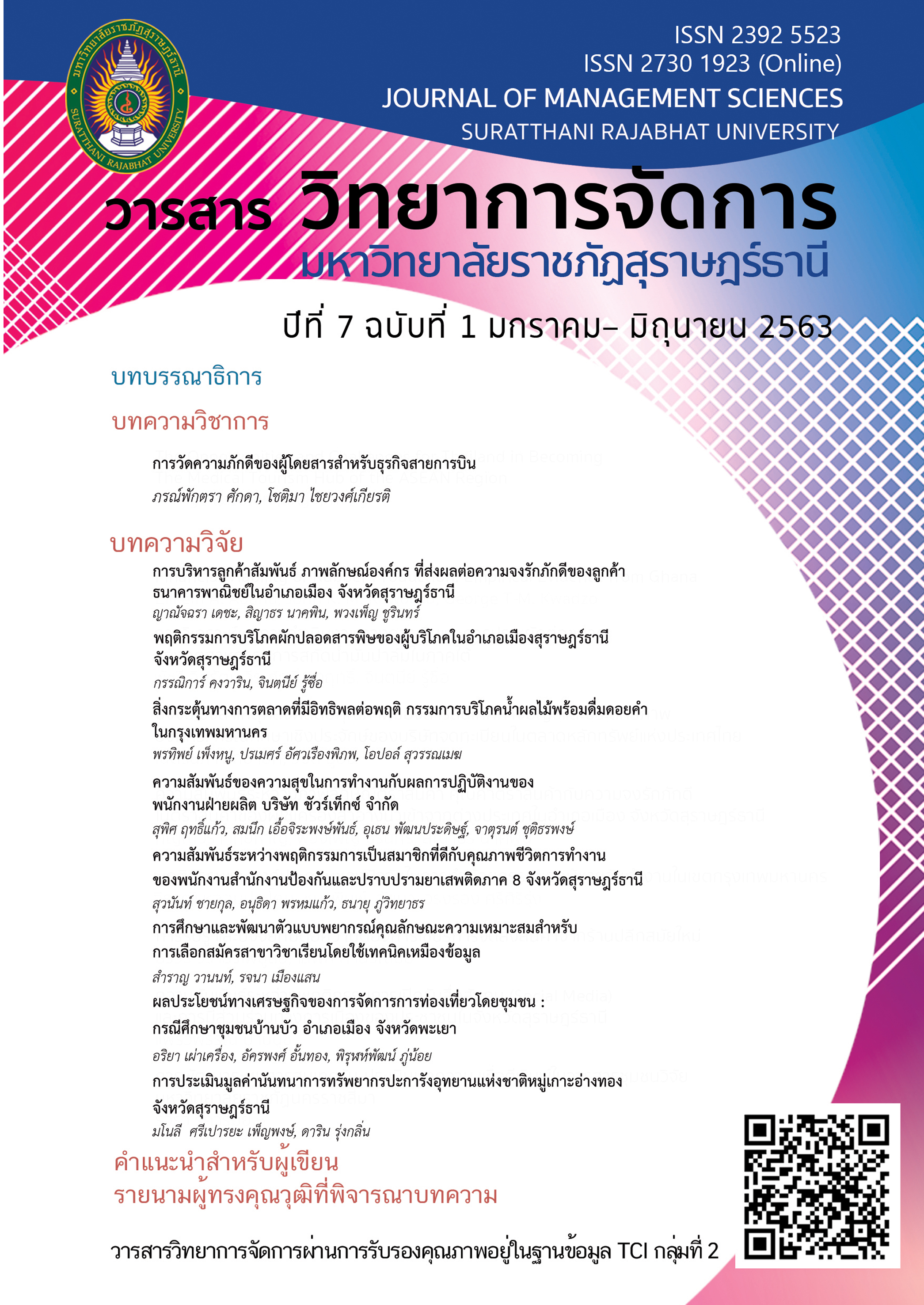Measuring Customer Loyalty for Airline Business
Main Article Content
Abstract
This article aims to propose factors measuring airline business customer loyalty. Prevalent previous research papers were systematically studied, analyzed and synthesized. From offering customer loyalty factors that are relevant to today's changing aviation business and by discussing factors that influence decisions and relationships with current airline trends the study found that a combination of attitude and behavior can be used to measure loyalty of airline passengers in 3 aspects: pre-flight service factor, in-flight service factors and post-flight service factor.
The researcher suggests that Airline Customer Service Executives should find various measures in order to develop a comprehensive service. Focusing on customer service is more important, especially in the field of sales promotion in order to be in the most accordance with the behavior and attitude of the passengers.
Article Details
References
ณัฐพัชร์ ล้อประดิษฐ์พงษ์. (2549). คู่มือสํารวจความพึงพอใจลูกค้า. กรุงเทพฯ: ประชุมทองพริ้นติ้ง กรุ๊ป.
ดารากร ยักกะพันธ์, มนตรี วีรยางกูร และวรพงศ์ ภูมิบ่อพลับ. (2560).ความสัมพันธ์ระหว่างคุณภาพบริการและผลการดำเนินงานของธนาคารพาณิชย์ในประเทศไทย. วารสารวิทยาการจัดการ, 4(2), 232-255.
นพรัตน์ รามสูต. (2548). การรับรู้กลยุทธ์ทางการตลาด ความพึงพอใจใช้บริการและความภักดีต่อตราสินค้าของผู้โดยสารสายการบินต้นทุนต่ำ และสายการบินไทย. (วิทยานิพนธ์วิทยาศาสตรมหาบัณฑิต). เชียงใหม่: มหาวิทยาลัยเชียงใหม่.
พาขวัญ ชูอำไพ และชลิตา ศรีนวล. (2560). การวิเคราะห์ความพึงพอใจของผู้ใช้งานระบบบัญชีสามมิติ ในสถาบันเทคโนโลยีพระจอมเกล้าเจ้าคุณทหารลาดกระบัง.วารสารวิทยาการจัดการ, 4(2), 143-173.
ยุทธพงษ์ พิมพ์พิพัฒน์. (2559). ความภักดีของลูกค้าตามแนวทางการบริหารลูกค้าสัมพันธ์ของลูกค้าร้านสะดวกซื้อ. วารสารมหาวิทยาลัยเทคโนโลยีราชมงคลสุวรรณภูมิ ฉบับมนุษยศาสตรและสังคมศาสตร์, 1(1), 14-28.
วิลาสินี พิมพ์ไพบูลย์. (2544). ปัจจัยทางการตลาดที่มีอิทธิพลต่อความภักดีต่อตราสินค้า. (วิทยานิพนธ์นิเทศศาสตรมหาบัณฑิต). กรุงเทพฯ: จุฬาลงกรณมหาวิทยาลัย.
ศิมาภรณ์ สิทธิชัย และ สิญาธร ขุนอ่อน. (2558). การวัดความภักดีของลูกค้าสำหรับธุรกิจโรงแรม. วารสารนักบริหาร, 35(1), 64-74.
องครักษ์ ธรรมวิหาร. (2559). ทัศนคติด้านคุณภาพการบริการที่ส่งผลต่อความจงรักภักดีของผู้โดยสารสายการบินไทยแอร์เอเซีย. (การค้นคว้าอิสระ หลักสูตรศิลปศาสตรมหาบัณฑิต). กรุงเทพฯ: มหาวิทยาลัยเกษมบัณฑิต.
แอร์เอเชีย. (2561). ข้อกำหนดและเงื่อนไขการบินสำหรับเที่ยวบิน QZ. สืบค้น 14 กรกฎาคม 2561, จาก https://www.airasia.com/th/th/about-us/terms-and-conditions-qz.page
An, M. & Yonghwi, N. (2009). Airline customer satisfaction and loyalty: impact of in-flight service quality. Service business, 3(3), 293-307.
Anderson, E. & Sullivan, M.W. (1991). Intra‐industry Differences in the Impact of Product Performance on Customer Satisfaction. University of Michigan‐School of Business Administration
Andreas, H.Z. (2001). Relative attitudes and commitment in customer loyalty models, Some experiences in the commercial airline industry. International Journal of service industry Management, 12(3), 269-294.
Andreassen, T W. (1995). Satisfaction, Loyalty and Reputation as Indicators of Customer Orientation in the Public Sector. International Journal of Public Sector Management, 7(2), 16-34.
Azmi, A., Ariffin, M., Aliah, H., Salleh, M., Norzalita, A.A., & Astuti, A. A. (2010). ‘Service Quality and Satisfaction for Low Cost Carriers’. International Review of Business Research Papers, 6 (1), 47–56.
Baker, D. & Mc. A. (2013). ‘Service Quality and Customer Satisfaction in the Airline Industry: A Comparison between Legacy Airlines and Low-Cost Airlines’. American Journal of Tourism Research, 2 (1), 67–77.
Boora, K.K., & Singh, H. (2011). Customer loyalty and its antecedents: A conceptual framework. Asia Pacific Journal of Research in Business Management, 2(1), 151-164.
D.C. Gilbert. (1996). Relationship marketing and airline loyalty schemes. Tourism Management, 17(8), 575-582.
Fang-Yuan, C., Yu-Hern, C., & Yi-Hsin, L. (2012). Customer perceptions of airline social responsibility and its effect on loyalty. Journal of air Transport Management, 20, 49-51.
Gremler, D.D., & Brown, S. W. (1996). Service loyalty: Its nature, importance and implications.In B. Edvardsson, S. W. Brown, R. Johnston, & E. Scheuing (Eds.),QUISV: Advancing Service Quality: A Global Perspective,171-181.
Hirschman, A.O. (1970). “Exit, voice, and loyalty: responses to decline in firms”. Organizations, and States, Harvard University Press, Cambridge, MA.
Hongwei, J., & Yahua, Z. (2016). An investigation of service quality, customer satisfaction and loyalty in China’s airline market. Journal of air Transport Management, 57, 80-88.
Ilias, V., & Zhibin, L. (2014). Drivers of airline loyalty: Evidence from the business travelers in china, Transportation research Part E, 71, 1-17.
International Civil Aviation Organization. (2018a). Air Transport, Passengers Carried. Retrieved August 05,2018, from https://data.worldbank.org/indicator/IS.AIR.PSGR.
———. (2018b). Low Cost Carriers (LCCs). Retrieved August 05,2018, from https://www.icao.int/sustainability/Pages/Low-Cost-Carriers.aspx.
Ivanauskiene, N., & Auruskevicien, V. (2009). Loyalty programs challenges in retail banking industry, Economics & Management, 14, 407-412.
Josip, M., & Darko, P. (2011). What drives passenger loyalty to traditional and low-cost airlines? A formative partial least squares approach. Journal of air Transport Management, 17, 237-240.
Juliet Namukasa, (2013). The influence of airline service quality on passenger satisfaction and loyalty, the case of Uganda airline industry, The TQM Journal, 25(5), 520-532.
Melike Arslan. (2009). A Study to determine the effects of customer value on customer loyalty in airline companies operating: Case of Turkish Air Travelers, International Journal of Business and Management, 4(6), 154-162.
Myungsook, A.,& Yonghwi, N. (2009). Airline customer satisfaction and loyalty: impact of in-flight service quality. Service business, 3(3), 293-307.
Oliver, R. L. (1997). Satisfaction: A behavioral perspective on the consumer. Boston MA: Irwin/McGraw-Hill.
———. (1999). Whence Consumer Loyalty?. Journal of Marketing, 63, 33-44.
Pong, L.T. & Yee, T.P. (2001). An integrated model of service loyalty. Retrieved August 15, 2018, from http://www.sba.muohio.edu/abas/2001/brussels.
Sara, D., Klaus, G., Bettina, G,, & Anna, K. (2011). Key drivers of airline loyalty. Tourism Management, 32, 1020 – 1026.
Tor, W. A., & Bodil, L. (1998). "Customer loyalty and complex services: The impact of corporate image on quality, customer satisfaction and loyalty for customers with varying degrees of service expertise", International Journal of Service Industry Management, 9(1), 7 – 23.
Wan-ping, P., & Hsieh-Hong, H. (2011). Effects of promotion on relationship quality and customer loyalty in the airline industry: The relationship marketing approach. African Journal of Business Management, 5, 4403-4414.
Yu-Hern, C., & Fang –Yuan, C. (2007). Relational benefits, switching barriers and loyalty: A study of airline customers in Taiwan. Journal of air Transport Management, 13(2), 104-109.
Zeithaml, V. A., & Berry, L. L., & Parasuraman, A. (1996). The behavioral consequences of service quality. Journal of Marketing, 60, 31-161.
Zhang, A., Shinya H., Hajime, I., & Tomoki, I. (2008). Low-Cost Carriers in Asia:Deregulation, Regional Liberalization and Secondary Airports. Research in Transportation Economics, 24, 36–50.


